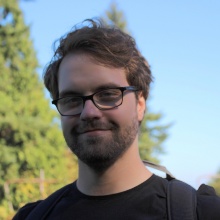Contact
Herdweg 51
70174 Stuttgart
Germany
Room: 020
Office Hours
Please write an email to make an appointment. Tuesday to Thursday works best.
Subject
- Character and professional networks in superhero comics
- Transmedia studies
- (Social) network analysis
- Social Media data analysis
- Polarization
- WS 18/19: Exercize class for "Theoretical and Computer Science basics for the Digital Humanities" (German)
- WS 18/19: Ring lecture "Computer Science introduces itself - Introduction for Humanists" (German)
- SS 19: Project seminar, group "Network analysis" (German)
- WS 17/18: Exercize class for "Theoretical and Computer Science basics for the Digital Humanities" (German)
- SS 17: Project seminar, group "Agent-based modeling" (German)
- WS 16/17: Introduction to Digital Humanities (German)
- 05/2016 - now: University of Stuttgart, research associate and doctoral student at the department of Digital Humanities, Institute of Literary Studies
- Dissertation topic: Character networks and professional networks in U.S. superhero comics
- 04/2013 - 09/2015: University of Bremen, student assistant at the Institute of Sociology, Department of Sociological Theory
- 10/2012 - 09/2015: M.A. Sociology and Social Research, University of Bremen
- Master thesis: Methodological perspectives of Topic Modeling for Framing Analysis
- 10/2008 - 09/2011: B.A. Sociology, University of Osnabrück
- Bachelor thesis: Relationship of social movements to the old and new media - the case of Anonymous
In my PhD thesis, I show how Marvel and DC build their transmedial storyworlds. To do this, I merged data of the Marvel and DC Fandom wikis as well as comics.org (ranging from the 1960s to 2018; data on comics, movies, tv series and others). The resulting dataset allows me to describe and model the evolution of character networks (based on co-occurence in stories) as well as the network of professional collaborations.
I am especially interested in notions of narrative momentum. Transmedial stories, and serial content in general, lives on, expands and stays interesting for consumers through the narratives implied by the world already established: if Superman and Batman are together in a team, this generates fan questions, and therefore potential stories. For instance on how such unequal characters manage to make decisions - or simply on who has coffee duty in the JLA Watchtower.
To research how this kind of worldbuilding is achieved (perhaps differently) for Marvel and DCs heavily interconnected and long-lived storyworlds, I look at how characters move towards one another in the dynamic co-occurence network - how their storyworlds overlap more or less over time and thus imply new connections.
Which characters and their storyworlds have more momentum over time and how much and when does the overall narrative universe concentrate on these characters? Does this differ for some of their traits (e.g. gender)? And does this produce unwanted incongruities that influence brand recognition negatively (storyworlds differing heavily between, e.g., movies and comics)?
As the creative process in U.S.-American comics is heavily collaborative, I am also interested in the social connections established through previous collaborations. Is professional closeness between creatives a predictor of character choice? Or are classic network dynamics like preferential attachment or triadic closure better at predicting future relations between characters?


